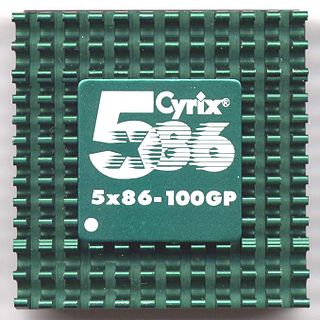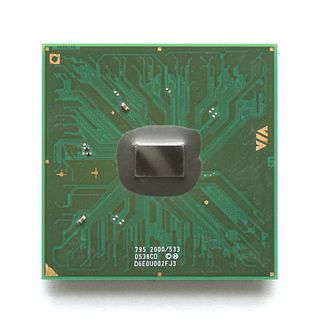486 sockets


The Pentium OverDrive is a heavily modified, 3.3 volt Pentium P54 core manufactured on 0.6 micrometer technology. It is fitted with a 486-compatible bus unit (though with an increased pin-count), an integrated heatsink and fan, and 32 kB of level 1 cache, double the 16 kB offered on regular P54C chips. [1] As the data bus was effectively reduced to 32-bit width, per-clock performance was much lower than that of a 'regular' Pentium, though still substantially faster compared to a similarly clocked 486 owing to the Pentium's architectural improvements, such as the much improved FPU. It was also equipped with an integrated 3.3 volt power regulator as many 486 motherboards only provided 5 volt power.
The 63 MHz model was launched in February 1995, and supported 25 MHz bus systems. The much faster 83 MHz version, which supported both 25 (63 MHz effective) and 33 MHz bus systems, launched much later the same year on September, and was very expensive at $299 compared to other upgrade alternatives, such as those based on AMD's 5x86 and Cyrix's Cx5x86 chips. [2]
The processor's heatsink is permanently attached, and the removable fan module is powered via spring-like metal prongs that connect to a trio of conductors on the surface of the chip. The clip that releases the fan is visible in the first photo, at the top left corner of the CPU. The central plastic "column" that leads from the center of the fan houses the fan wiring and leads down the side of the heatsink at this corner. The small plastic points at each top left of this column are the locking mechanism for the fan and are released by squeezing them. The opposite corner of the CPU has a latch that locks the fan around underneath the heatsink, by swinging into place upon assembly. The processor monitors the fan and will throttle back on clock speed to prevent overheating and damage if the fan is not operating. This is a predecessor to the internal temperature detection and protection in Intel's modern processors.
Compatibility and performance
During development, Intel had changed the design specification, causing various compatibility and performance problems with some boards that were previously fully compatible. For instance, the Packard Bell 450 motherboard required a specially-designed interposer to be installed between the processor and the motherboard to cope with the changed specification, with the unfortunate consequence of precluding access to the motherboard's level 2 cache, resulting in sub-par performance. [3] In addition, some older chipsets do not support the write-back functionality of the chip's level 1 cache, which could also reduce performance. However, the majority of Socket 3 motherboards, particularly later (post-1994) VLB and most PCI boards, provide proper support for the Pentium OverDrive including fully operational access to the level 2 cache, and many earlier boards also support the processor with varying levels of compatibility and performance.
Performance-wise, many popular synthetic benchmarks of the time showed the Pentium OverDrive under-performing its much cheaper and higher-clocked rivals, though its real-world performance (given the motherboard cache was being optimally used) could be much different: programs that were floating-point dependent or optimized for the Pentium architecture (as were both becoming increasingly common in the mid to late nineties) derived a more substantial benefit from the Pentium OverDrive, particularly the 83 MHz version. In addition, it fully supported programs and operating systems specifically coded for the Pentium architecture, such as many emulators, multimedia utilities and even later Windows operating systems and games; however, the benefit of running such programs on a clock- and motherboard bus-constrained system may be questionable.
Models
PODP5V63
- Introduced February 3, 1995
- 234 pins, P24T pinout
- 5 or 3.3 volts
- L1 Cache 32 kB (16 kB + 16 kB)
- 63 MHz on 25 MHz front side bus (25 × 2.5)
PODP5V83
- Introduced September 1995
- 234 pins, P24T pinout
- 5 or 3.3 volts
- L1 Cache 32 kB (16 kB + 16 kB)
- 83 MHz on 33 MHz front side bus (33 × 2.5)
Some 63 CPU models (part number 109X4405H6J05) have 234 pins instead of 235. Some CPUs came with the pin chopped off (Pin A4) and others had the pin completely missing and covered with the encapsulation.























